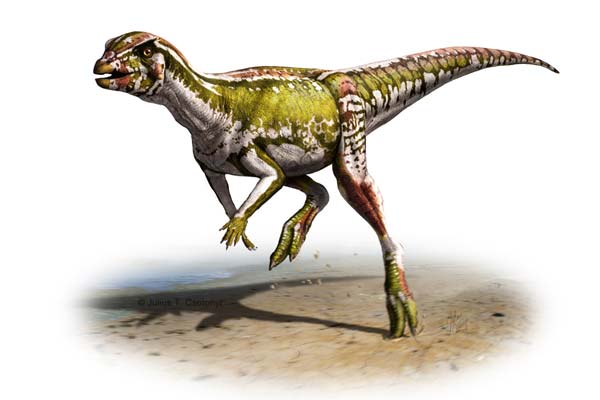
Small, speedy plant-eater extends knowledge of dinosaur ecosystems
Published: May 23, 2013
Dinosaurs are often thought of as large, fierce animals, but new research highlights a previously overlooked diversity of small dinosaurs.
In the Journal of Vertebrate Paleontology, a team of palaeontologists from the University of Toronto, Royal Ontario Museum, Cleveland Museum of Natural History and University of Calgary have described a new dinosaur, the smallest plant-eating dinosaur species known from Canada: Albertadromeus syntarsus.
Earlier this month the same team made headlines around the world with another dinosaur discovery: a dog-sized dinosaur they named Acrotholus audeti which may be the oldest pachycephalosaur. (Read more about that discovery.)
Albertadromeus syntarsus was identified from a partial hind leg, and other skeletal elements, that indicate it was a speedy runner. At approximately 1.6 m (5 ft) long, it weighed about 16 kg (30 lbs) – comparable to a large turkey – and lived in what is now southern Alberta in the Late Cretaceous, about 77 million years ago. Albertadromeus syntarsus means "Alberta runner with fused foot bones".
Unlike its much larger ornithopod cousins, the duckbilled dinosaurs, its two fused lower leg bones would have made it a fast, agile two-legged runner. This animal is the smallest known plant-eating dinosaur in its ecosystem, and it likely used its speed to avoid predation by the many species of meat-eating dinosaurs that lived at the same time.
Caleb Brown, a PhD candidate in the Department of Ecology and Evolutionary Biology at the University of Toronto and lead author of the study, offers some explanation for the scarcity of knowledge about small-bodied dinousaurs from the period.
“We know from our previous research that there are preservational biases against the bones of these small dinosaurs, in that they are less likely to be preserved than larger ones because they are more delicate and are often destroyed before being fossilized,” said Brown. “We are now starting to uncover this hidden diversity, and although skeletons of these small ornithopods are both rare and fragmentary, our study shows that these dinosaurs were more abundant in their ecosystems than previously thought.”
Albertadromeus was discovered in 2009 by study co-author David Evans of the Royal Ontario Museum as part an on-going investigation with Michael Ryan of the Cleveland Museum of Natural History into the evolution of dinosaurs in the Late Cretaceous of North America. The known dinosaur diversity of this time period is dominated by large bodied plant-eating dinosaurs.
The relatively poor understanding of these small dinosaurs comes from a combination of the processes related to decay and preservation, and biases in the way that material has been collected, with larger bones being easier to find and work on. Small skeletons are more prone to destruction by carnivores, scavengers and weathering processes, so fewer small animals are available to become fossils and smaller animals are often more difficult to find and identify than those of larger animals.
"Albertadromeus may have been close to the bottom of the dinosaur food chain but without dinosaurs like it you'd not have giants like T. rex," said Ryan. “Our understanding of the structure of dinosaur ecosystems is dependent on the fossils that have been preserved. Fragmentary, but important, specimens like that of Albertadromeus suggest that we are only beginning to understand the shape of dinosaur diversity and the structure of their communities.”
“You can imagine such small dinosaurs filling the niche of animals such as rabbits and being major, but relatively inconspicuous, members of their ecological community” said Anthony Russell of the University of Calgary.
Sean Bettam is a writer with the University of Toronto Faculty of Arts & Science



